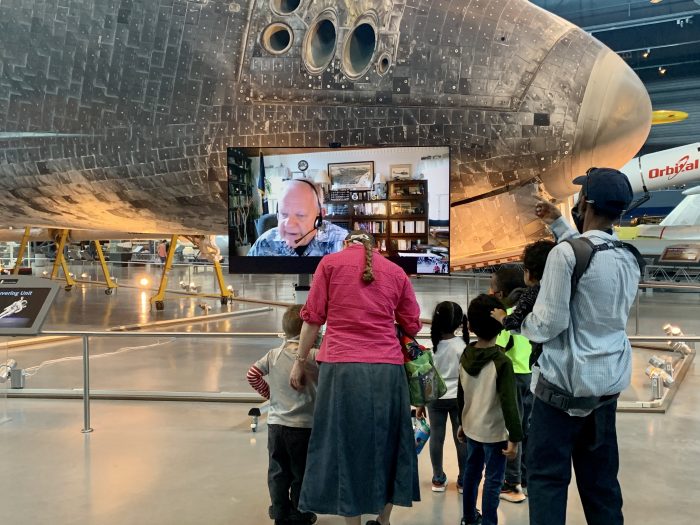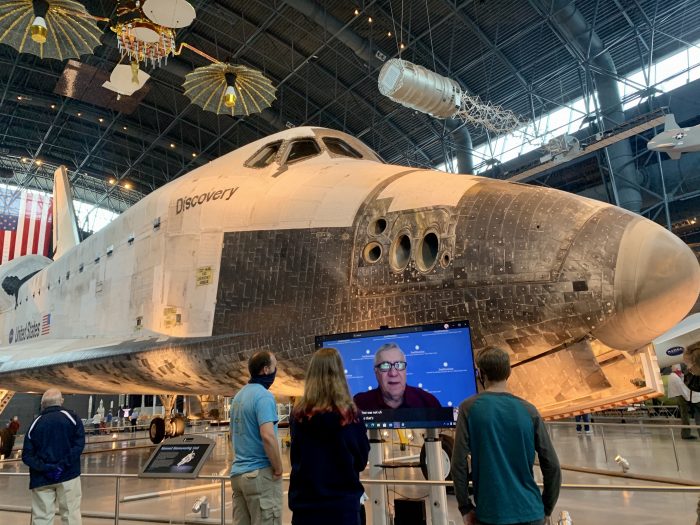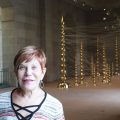Virtual Docenting at the National Air and Space Museum
Docent Joe Romito describes the challenges of transitioning to Virtual Volunteer Artifact Stations at the popular Udvar-Hazy Center in Chantilly, Virginia.
From the moment the pandemic led to the shutdown of all Smithsonian Institution facilities in March 2020, docents at the National Air and Space Museum began looking forward to the day when they could return to doing what they enjoy most: talking with visitors about the museum’s tremendous collection of air and space artifacts and telling the stories of the people and events associated with those artifacts. Thanks to innovative thinking and a lot of hard work by museum staff and the docents themselves, Air and Space docents were able to resume their docent duties in September with the initiation of the museum’s Virtual Volunteer Artifact Station Program.
The program was developed by the Visitor Services department, the group that oversees the 300-plus members of the docent corps. As many of you probably know, the National Air and Space Museum is one museum with two public facilities: the National Mall Building in Washington, D.C., and the Steven F. Udvar-Hazy Center in Chantilly, Virginia. The Smithsonian’s senior leaders decided to reopen the Udvar-Hazy Center and the National Zoo to a limited number of visitors in July. Although visitors were allowed, due to health and safety concerns, no volunteers were permitted back in the building. So the Visitor Services staff began thinking about ways to establish a virtual presence for the docents at the Udvar-Hazy Center. The staff developed the Virtual Volunteer program under the leadership of Richard Weld, Supervisory Specialist for Visitor Services. The program initially consisted of the Visitor Services volunteers who provide general information at the museum’s John L. Plueger Family Welcome Desk, and soon expanded to include docents. Weld commented that “Our docents bring the museum to life for our visitors, and we wanted to find a way for them to talk with the visitors even if they couldn’t be physically present in the building.”

National Air and Space Museum, photo by Rachel Owens.
Implementation required teamwork among multiple organizations on the museum’s staff, but the concept is fairly simple: a 65-inch monitor with a camera and microphone is placed at one of the Udvar-Hazy Center’s major artifacts, a virtual meeting is established via Internet connection, and a docent working from home joins the meeting to talk with visitors as they view the artifact. The program would be in operation from 10 a.m. to 3:00 p.m. daily, with docents taking one-hour shifts. With those hours established at three artifact locations, the program provided more than 100 opportunities per week for docents to engage visitors.
Weld got the docents involved through the Docent Council. The Council had established a group called the Post-Corona Operations Committee (the PCOC, and yes, they call themselves the “Peacocks”), and it was this group that worked closely with the staff to flesh out the virtual program. The Visitor Services team, with input from the Peacocks, settled on the locations for the monitors, covering three of the Udvar-Hazy Center’s most significant artifacts: the SR-71 Blackbird spy plane, the Space Shuttle Orbiter Discovery, and the B-29 Superfortress Enola Gay.
The docents, of course, already had the essential knowledge of the artifacts. But this new approach to docenting created situations that were different from what they were used to and required creative solutions.
Here are the major challenges.
- The platform for the virtual meeting would be Microsoft Teams, a program that most docents were not familiar with. So the staff developed and conducted remote training sessions to bring the docents up to speed.
- Pre-pandemic, the docents’ usual role was to lead groups of 10-20 (or more) visitors through the museum. Because of social distancing guidelines, docents would now be dealing with individuals or very small groups, and these visitors would be able to stand in front of the monitor for just a few minutes before moving on. This meant that each engagement would be brief, giving the docent less time than usual to talk about a given artifact. Most docents developed 3-5 minute mini-talks about the major artifact where the monitor was positioned. These canned remarks were helpful, but one of the first lessons learned was that once the docent got the conversation started, most visitors would ask a lot of questions and prepared remarks were usually not needed.
- Visitors were not expecting to talk with a “live” human being, and some visitors walked past the monitors under the mistaken impression that the face on the screen was a recorded announcement. So docents had to find ways to “capture” people as they walked through the building. When a docent on the monitor called out to visitors, in many cases the response was something along the lines of, “Are you real?” Phrases such as “The Space Shuttle is really big, isn’t it?” or “Did you know that the airplane you’re looking at [the SR-71] flew across the country in about an hour?” or “I like your hat.” proved to be effective ways to start a conversation.
- The docent’s field of view was fixed by the position of the camera, but visitors standing in front of the monitor were able to look around the museum in all directions. This led to frequent situations in which a visitor would point in one direction or another and ask the docent, “What’s that?” That’s a fair question, but answering it required the docent to be able to figure out which of the many nearby artifacts the visitor was pointing at. To prepare docents for this sort of question, the Peacocks developed robust lists of questions that were likely to be asked at each of the virtual stations and shared these with all Udvar-Hazy Center docents.

National Air and Space Museum, photo by Rachel Owens.
In spite of initial doubts, docents found the program to be satisfying and enjoyable. Docent Van Rametta commented, “I was skeptical! You’re telling me the visitors and docents are going to like this experience? But I was wrong! It was fun for both [me and the visitors]. I would not be surprised to see this technology used in some capacity even after we are all back inside the museum.” Fellow docent Larry McKinley echoed those thoughts: “I didn’t think my enthusiasm would come across to the visitors. After five minutes of being with the visitors, I found the enthusiasm, fun, and visitor questions remained the same [as with the in-person experience] and I was having fun again.”
Air and Space visitors were equally enthusiastic. As one visitor commented, “This is a brilliant way to connect with the aircraft … I was absolutely delighted by the usefulness of the technology and knowledge of the docent.”
With this positive experience to date, where is the program headed? Well, first we have to note that the program has experienced a temporary roadblock, which is hardly surprising in the midst of the pandemic. The Virtual Volunteer program was in operation for just two months before being shut down in November. COVID-19 numbers were trending in the wrong direction, so Smithsonian leaders took the cautious step of once again closing the Udvar-Hazy Center and the other Smithsonian units that had reopened. When the Udvar-Hazy Center once again opens to limited numbers of visitors, docents will staff the three original virtual stations, along with a fourth station in front of the Boeing 307 Stratoliner in the museum’s Commercial Aviation section. The reopening of the National Mall facility will follow later, and the plan is to have three virtual stations in place on that date. Likely locations at the Mall building are the Wright Brothers Gallery, the Space Race Hall, and the Boeing Milestones of Flight Hall. Drawing on the lessons learned at the Udvar-Hazy Center, the Peacocks have already developed extensive lists of questions likely to be asked at these locations, and the staff will be prepared to conduct the necessary Teams training for the Mall docents. The reopening dates for both locations have not yet been established.
The museum’s Virtual Volunteer Artifact Station program has proven to be extremely popular with everyone involved – the museum staff, the docents, and (most importantly) our visitors. For any museum that is admitting visitors but has opted to not yet allow its docents to return to onsite work, a program like this can be a great way to get the docents involved and to enhance the museum experience for visitors.
Posted: 16 April 2021
- Categories:







